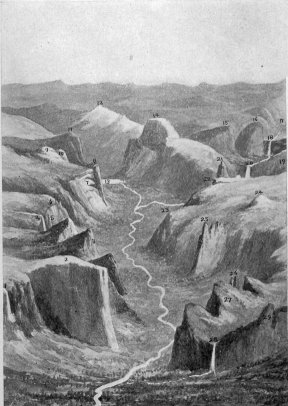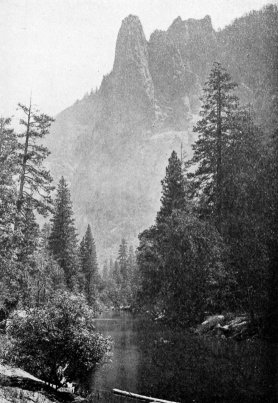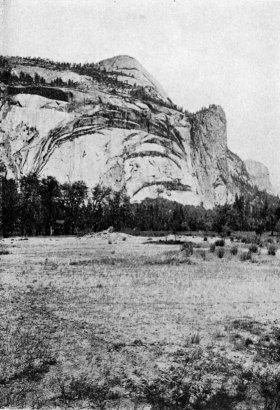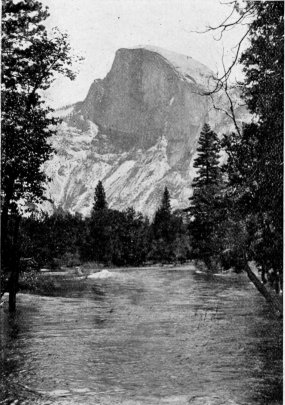Yosemite > Library > Yosemite Valley >
Peaks & Domes >
The Yosemite Valley (1910) by Galen Clark
Next: Waterfalls
•
Contents
•
Previous: Author’s Theory
PROMINENT PEAKS AND DOMES IN
YOSEMITE.
El Capitan.
AT the entrance to the Valley on the
north side is El Capitan, a type of
enduring massiveness, being an enormous
block of solid granite thirty-three
hundred feet in height, with a smooth
vertical face of over one hundred and
sixty acres in superficial area. In one
place the top edge overhangs the base
nearly one hundred feet. In a slight
depression, about one thousand feet
above the base, there is growing a lone
pine tree which is by actual measurement
eighty feet in height.
On another part of the face of El Capitan
is plainly to be seen, in certain conditions
of light, the figure of a man
facing west, and apparently traveling in
that direction, clothed in a flowing robe
and a low crowned hat. The old Indians
of Yosemite called this figure To-tau-kon-nu-la,
and held it in supreme reverence
as a great chieftain of their remote
ancestors.
On the crowning ridge of El Capitan,
thirty-six hundred feet above the Valley,
there is a juniper tree growing which is,
thirty-four feet in circumference, breast
high.
Three Brothers.
The Three Brothers, thirty-eight hundred
and thirty feet high, are a triple
group of rocks which rise in steps, one
back of the other, with a smooth, slanting
KEY TO BIRDS-EYE VIEW ON OPPOSITE
PAGE. (Drawing by Chris. Jorgensen).—1. Ribbon
Fall. 2. El Capitan. 3. Three Brothers. 4. Yosemite Falls.
5. Lost Arrow. 6. Yosemite Point. 7.
Royal Arches. 8. Washington Column. 9. North Dome.
10. Basket Dome. 11. Mt. Watkins. 12.
Cloud’s Rest. 13. Mirror Lake. 14. Half Dome.
15. Mt. Broderick. 16. Liberty Cap. 17. Little Yosemite
18. Nevada Fall. 19. Panorama Rock. 20.
Vernal Fall. 21. Grizzly Peak. 22. Glacier Point.
23. Union Point. 24. Sentinel Dome. 25. Sentinel Rock.
26. Cathedral Spires. 27. Cathedral Rocks.
28. Bridal Veil Fall. 29. Leaning Tower.
|

BIRDS-EYE VIEW
For key see opposite page
|
western surface. The extreme top
of the highest one cannot be seen from
the point where photographs are usually
taken, but farther up the Valley it is
plainly seen, and known as Eagle Peak,
thirty-nine hundred feet high.
Three Graces. Cathedral Rocks.
On the other side of the Valley, opposite
El Capitan, is another great group
of rocks which, as seen from the west, is
called the Three Graces. In general appearance
these rocks resemble the Three
Brothers. Farther up the Valley this
same group presents a different appearance,
and is known as the Cathedral
Rocks.
Cathedral Spires.
Closely adjoining the Three Graces,
but set a little farther back, are the two
unique and graceful pinnacles called the
Cathedral Spires. One of these is said
to be twenty-five hundred and seventy-four
four feet high, the other twenty-six hundred
and seventy-eight feet.
These spires are isolated columns of
rock standing out from, but connected at
the base with, the main walls of the Valley.
Two such symmetrical columns, so
near alike and so near together, like two
towers of a Gothic cathedral, form a
very rare and interesting feature in
mountain scenery.
Sentinel Rock.
Further up the Valley, on the same
side, is an elevated point known as Sentinel
Rock. Its height is thirty-one
hundred feet. The walls of the Valley
on each side of it slope back, leaving it
standing squarely out with a perpendicular
face of nearly two thousand feet,
below which it descends at a steep angle.
to the floor of the Valley.
Glacier Point.
Near the upper end of the Valley is,

SENTINEL ROCK
3,100 feet
[Photo by George Fiske]
|
the locality known as Glacier Point,
thirty-two hundred and fifty feet high.
From this elevated standpoint we get
a fine view of all the upper part of the
Valley and surrounding walls, also Vernal
and Nevada Falls, and a grand and
extensive panorama of the Sierra Nevada
range.
Eagle Peak.
This peak, the tallest one of the Three
Brothers, is thirty-nine hundred feet
above the Valley floor. From this point
we get the finest and most extensive view
of the Valley, and also a part of the High
Sierras in the distance.
Yosemite Point.
Yosemite Point, just east of Yosemite
Falls, is thirty-two hundred and twenty
feet above the Valley. Here also can be
obtained a magnificent view of the Valley
far below.
North Dome. Royal Arches.
Washington Column.
The North Dome, thirty-seven hundred
and twenty-five feet high, is a great
rounded mass of granite made up of
huge concentric plates of rock overlapping
each other.
Lower down on the face of the wall,
where the edges have been broken off
and carried away, these concentric plates
form the great Royal Arches. These
Arches show very plainly the concentric
structure of the dome, the top of which
is only accessible from the rear side.
Adjoining the Royal Arches is a fine
shaft of granite known as the Washington
Column.
The Half Dome.
The Half Dome, on the opposite side,
facing Teneiya Canyon, is five thousand
feet in height above the Valley, and is
the loftiest mass of rock of those considered
as a part of the Yosemite.

ROYAL ARCHES, NORTH DOME AND
WASHINGTON COLUMN
[Photo by George Fiske]
|
On the side fronting Teneiya Canyon
it is absolutely vertical for nearly two
thousand feet from the summit and then
falls off in a steep incline to the bottom
of the canyon.
On the opposite side the Half Dome
has a rounded form at the top, and grows
more and more steep to the bottom.
The whole appearance of this great
mass of rock is that of an originally
dome-shaped elevation with a very steep
curve, of which a great part of the western
half has been split off. This evidently
took place while Teneiya Canyon
was still occupied by the remains of the
great glacier which at an earlier period
filled it. This debris, falling upon the
glacier, was carried a little further down
and dropped when the glacier melted.
In the fall of the year 1876, George
Anderson, then a resident of Yosemite,
worked his way up to the top of the Half
Dome with drills, iron eyebolts and
ropes, and was the first man to stand
upon its lofty summit.
There is an area of many acres which
can be safely traveled over on the top,
and in many places, where soil has accumulated
from the disintegrated granite,
there are flowering plants and some
small trees.
From the top of the vertical side fronting
Teneiya Canyon there is a great open
crack extending back into the Dome
nearly one hundred feet. In dropping a
small pebble into this crack it can be
heard rattling down a long distance.
This great fracture in the rock was undoubtedly
made at the time the western
part of the dome was split off. This
great cataclysm I think must have been
caused by some tremendous subterranean
force upheaving this part of the
earth’s surface.

THE HALF DOME
5,000 feet
[Photo by George Fiske]
|
Next: Waterfalls
•
Contents
•
Previous: Author’s Theory
http://www.yosemite.ca.us/library/the_yosemite_valley/domes.html



